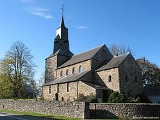
Waha
Encyclopedia
Waha is a Belgian
village located in the Province of Luxembourg
in Wallonia. In 1977 the village merged with Aye
, Hargimon, Humain, Marche-en-Famenne
, Marloie, On, Champlon and Roy to form the municipality of Marche-en-Famenne.
. In 1050 the present church of Saint Étienne was dedicated by the Liège bishop Theodwin (French: Théoduin).
The collegiate chapter
of Saint Étienne was dissolved during the time of the French First Republic
.
churches in Belgium. The nave
of the church is only four arches long. The choir has a rectangular shape and is unvaulted. It is also lower than the nave ceiling, which is not uncommon in early Mosan architecture
. The westwork
tower is slightly younger than the rest of the church.
In 1956-1957 the church underwent major restoration work as well as art historical investigation. It was then that the dedication stone from 1050 was found. There are also some sculptures by the Master of Waha in the church. The church's greatest treasure is the reliquary shrine
of Saint Étienne.
Belgium
Belgium , officially the Kingdom of Belgium, is a federal state in Western Europe. It is a founding member of the European Union and hosts the EU's headquarters, and those of several other major international organisations such as NATO.Belgium is also a member of, or affiliated to, many...
village located in the Province of Luxembourg
Luxembourg (Belgium)
Luxembourg is the southernmost province of Wallonia and of Belgium. It borders on the Grand Duchy of Luxembourg, France, and the Belgian provinces of Namur and Liège. Its capital is Arlon, in the south-east of the province.It has an area of 4,443 km², making it the largest Belgian province...
in Wallonia. In 1977 the village merged with Aye
Aye
Aye is a tiny village located near Marche-en-Famenne in Belgium. The inhabitants of Aye are called the "Godis" in the Walloon dialect. The postal code is 6900.- External links :...
, Hargimon, Humain, Marche-en-Famenne
Marche-en-Famenne
Marche-en-Famenne is a Walloon municipality located in the Belgian province of Luxembourg. It is the unofficial capital of the Famenne region, sandwiched between the Condroz, former land of the Condrusi, to the north and the Ardennes to the south....
, Marloie, On, Champlon and Roy to form the municipality of Marche-en-Famenne.
Etymology
The name "Waha" comes from the Celtic proper name "Wachart". The Latin name of the location was "Wachardi mansus", meaning "Wachart's dwelling".History
Waha in the 10th century belonged to the territory of count Immon. The first church was built only 100 meters from the present church and was dedicated to Saint Martin of ToursMartin of Tours
Martin of Tours was a Bishop of Tours whose shrine became a famous stopping-point for pilgrims on the road to Santiago de Compostela. Around his name much legendary material accrued, and he has become one of the most familiar and recognizable Christian saints...
. In 1050 the present church of Saint Étienne was dedicated by the Liège bishop Theodwin (French: Théoduin).
The collegiate chapter
Chapter (religion)
Chapter designates certain corporate ecclesiastical bodies in the Roman Catholic, Anglican and Nordic Lutheran churches....
of Saint Étienne was dissolved during the time of the French First Republic
French First Republic
The French First Republic was founded on 22 September 1792, by the newly established National Convention. The First Republic lasted until the declaration of the First French Empire in 1804 under Napoleon I...
.
Art historical significance
The church of Saint Étienne in Waha is one of the oldest RomanesqueRomanesque architecture
Romanesque architecture is an architectural style of Medieval Europe characterised by semi-circular arches. There is no consensus for the beginning date of the Romanesque architecture, with proposals ranging from the 6th to the 10th century. It developed in the 12th century into the Gothic style,...
churches in Belgium. The nave
Nave
In Romanesque and Gothic Christian abbey, cathedral basilica and church architecture, the nave is the central approach to the high altar, the main body of the church. "Nave" was probably suggested by the keel shape of its vaulting...
of the church is only four arches long. The choir has a rectangular shape and is unvaulted. It is also lower than the nave ceiling, which is not uncommon in early Mosan architecture
Mosan art
Mosan art is a regional style of art from the valley of the Meuse in present-day Belgium, the Netherlands, and Germany. Although the term applies to art from this region from all periods, it generally refers to Romanesque art, with Mosan Romanesque architecture, stone carving, metalwork, enamelling...
. The westwork
Westwork
A westwork is the monumental, west-facing entrance section of a Carolingian, Ottonian, or Romanesque church. The exterior consists of multiple stories between two towers. The interior includes an entrance vestibule, a chapel, and a series of galleries overlooking the nave...
tower is slightly younger than the rest of the church.
In 1956-1957 the church underwent major restoration work as well as art historical investigation. It was then that the dedication stone from 1050 was found. There are also some sculptures by the Master of Waha in the church. The church's greatest treasure is the reliquary shrine
Reliquary
A reliquary is a container for relics. These may be the physical remains of saints, such as bones, pieces of clothing, or some object associated with saints or other religious figures...
of Saint Étienne.

